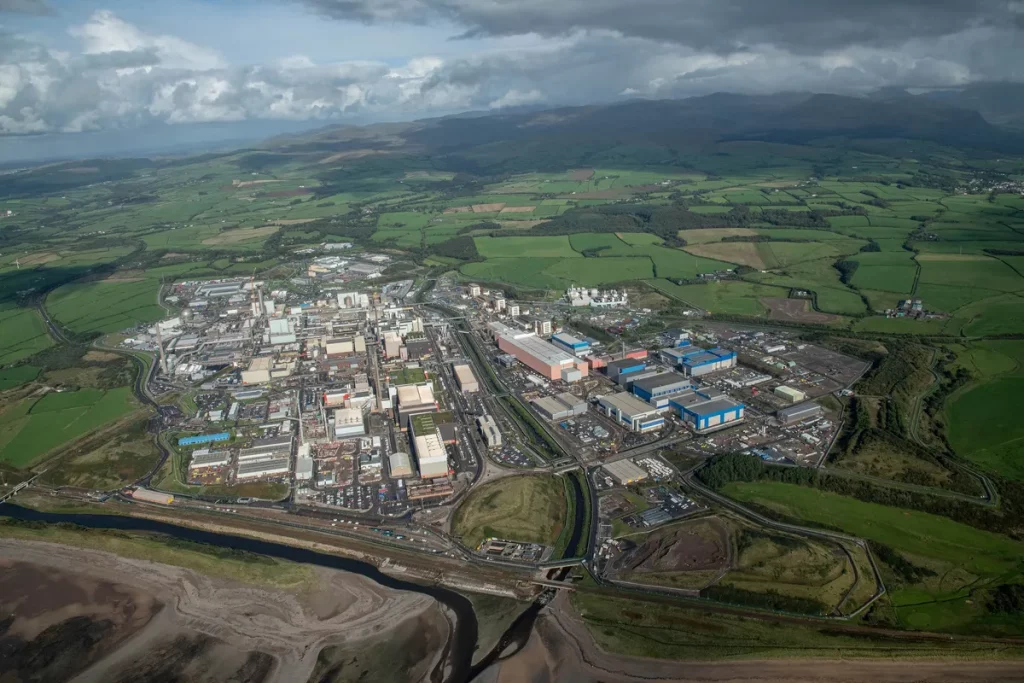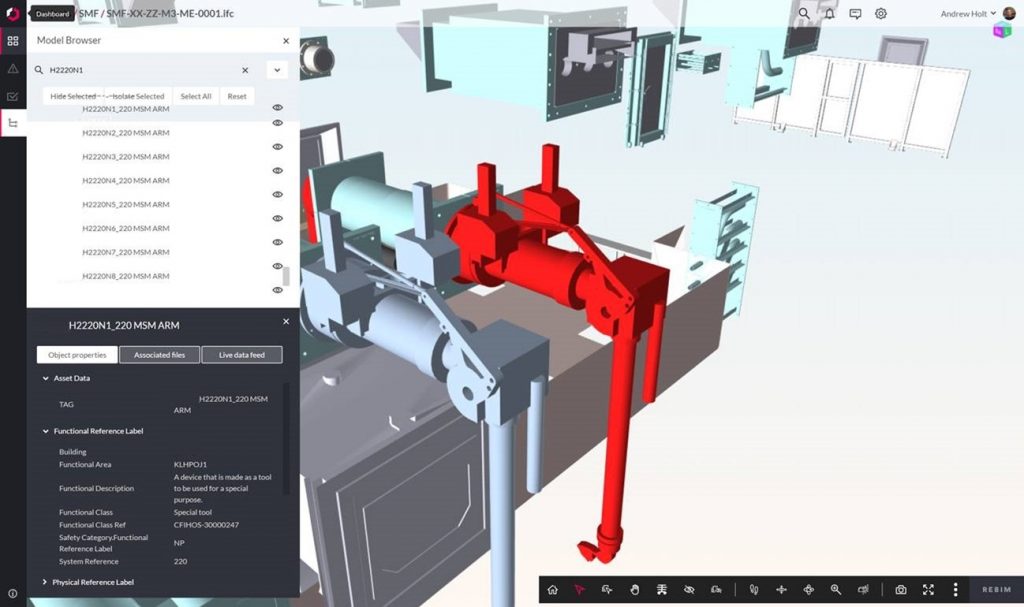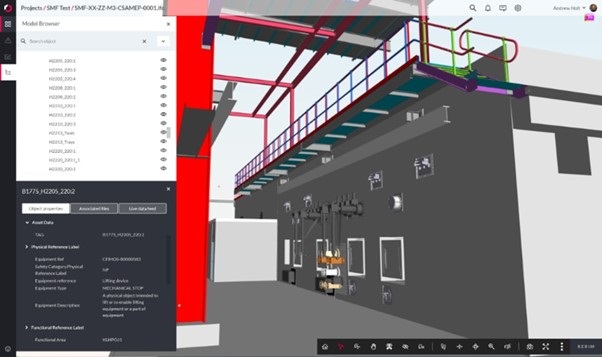
BIM in Operations and Maintenance Phase for Nuclear Decommissioning at Sellafield
Introduction
Alongside our strategic partners Assystem, Azurelope have implemented the REBIM® common data environment (CDE) as a vehicle to demonstrate the potential for future proofing the Operations and Maintenance (O&M) phase of a new flask maintenance facility that supports nuclear decommissioning at Sellafield.
Leveraging Building Information Modelling (BIM) principles and data modelling techniques in the REBIM® CDE, has provided a variety of benefits and insights into how BIM for O&M can be used effectively for:
- Maintaining, raising and tracking work orders for site assets and components.
- Information and knowledge management.
- Training.
- Health and Safety.
- Reporting and dashboarding.
- Compliance with engineering standards.

Project Primary Objective
The primary objective of this project was to demonstrate the delivery of lifecycle savings related to engineering effort and highlight how BIM can be used for a range of O&M, asset and information management processes.
There are significant savings to be made by future proofing maintenance management activities and switching away from a paper driven system, no longer double handling information and no longer straining to access the correct information for important operational activities.
As well as providing insight into how BIM for O&M can aid, future proof and integrate a variety of data sets into a powerful 3D asset geometric model, the project aimed to accelerate the Digital Transformation Programme at Sellafield, by bringing in a new approach to Enterprise Asset Management (EAM).
This enables Sellafield to demonstrate best value to Nuclear Decommissioning Authority stakeholders as well as the public.
The Need
Following a major organisational restructure, Sellafield is now undergoing a transformation of how it carries out business operations.
Enterprise Asset Management transformation is a significant part of this business transformation, which is focused on how assets are managed throughout their whole life from initial strategy, design and construction, operations and maintenance through to eventual decommissioning and land remediation.
A key enabler of this transformation is to “digitize” operational phase business processes beyond the design and construct phase of assets.
The need was to demonstrate that digital engineering and building information modelling data could be repurposed to carry out operations and maintenance tasks, previously carried out on paper and using multiple siloed systems.
Sellafield wanted to understand the steps needed to successfully transition the BIM data through life using suitably appropriate and fit for purpose tools. Another key metric was how much effort was required for a variety of scenarios including:
- Existing legacy assets with no useful digital data.
- Existing or recently constructed assets with some level of digital data (SMF).
- Current and future projects where the opportunity exists to create clean new data.
What Did We Do?
As part of this proof of concept, we:
- Cleaned existing project data for a key strategic area of a facility so that it could be efficiently repurposed as a demonstrator for the art of the possible during the Operations and Maintenance (O&M) phase.The chosen facility (SMF) is in its operational phase but is new and suitable for tangible benefits to be realised by asset management, system engineering and information management stakeholders.
- Constructed a new data model using the clients new Asset Information Requirements (AIR) standard to an existing dataset, enabling the data to be transitioned into the operations and maintenance phase for selected “in-cell” systems.
- Issued and generated a 3D digital Asset Information Model and software demonstration featuring the area within SMF.
- Received the collated as-built data from the project handover phase and using data modelling techniques, data validation processes and tools, retrofitted the information management solution and alignment of the digital outputs to the corporate Asset Information Requirements (AIR), whilst simultaneously futureproofing digital asset and maintenance management capabilities at SMF.
- Provided a series of scenarios to fulfil three use cases identified by the client. The scenario for each use case was based on every day activities and included using a specific sub-set of data within defined digital workflows. The use cases were based around three roles:
- System engineer – Overall responsibility for the system(s)
- Operator – The facility and system operator
- Maintenance engineer – Responsible for ensuring the plant components are maintained and inspected in line with the relevant maintenance and engineering standards.
- Worked jointly with the Asset Information Systems team at Sellafield to share the benefits, approach and digital transformation journey that was undertaken as part of this proof of concept.
Grant Traynor ~ System Engineer for SMF & SP/0255 Package, and Decom Engineering (MSSS) writes:
“BIM is an incredibly useful asset and tool to the wider Sellafield Ltd community, at all levels, skills, and disciplines, but particularly so to the System Engineer.
A significant part of a System Engineer’s work is the safe storage and retrieval of system and asset information. BIM provides us with this very important Single Source of Truth. Not only is this information from a trusted source, but also at the latest version.
Many hours of research and retrieval of information can be saved utilising BIM’s attribute of a single starting point to any search, and once completed, any search can be saved, saving time and effort later.
Also, the BIMs Digital Twin representation of Plant, Facility or System affords us all a fantastic briefing and training tool to a wide audience, even if dispersed over a multitude of geographical locations, not to mention the benefits of greatly reducing potential dose uptake when used for any pre-job brief, job or spatial planning and clash prevention.
BIMs ability to be utilised by the Operations and Maintenance community in both the planning, conduct of their work and post job recording of data, any defects identified and trending, will also be invaluable, not only to the System Engineer, but the Engineering, Maintenance, Operational and Asset Condition Management communities in general. All this accumulated information will be available to all, at all levels, skills, and disciplines in a single, trusted, and secure location.”
Insights And Outputs
This proof of concept demonstrated the successful ‘digitalisation’ of an existing operational asset, testing and adapting existing technology and methodology to align a pre Asset Information Requirements (AIR) facility to be ‘Enterprise Asset Management (EAM)’ compliant.
As with all industries, historic data was typically structured in such a way that made it difficult for optimum Operations and Maintenance functionality.

Our pilot provided a range of insights into how BIM can be used for O&M in order to:
- Reduce and prevent manually transcribing asset information and entering data into multiple disparate systems for Operations and Maintenance.
- Help establish a graded approach to improving and recovering asset data from legacy or ‘early BIM’ projects.
- Influence people and process changes in the operations phase, developing Sellafield’s capability to extract full value from an integrated and future proofed BIM and enterprise asset management common data environment.
- Accelerate learning, and explore unidentified opportunities and challenges, at lower risk than a site-wide rollout.
- Provide a tangible demonstration of the benefits of enterprise asset and maintenance management using BIM for O&M in the early operations and maintenance phases for the selected facilities.
- Create a federated means using BIM and data modelling techniques to connect the right people to the correct data.
- Harness the power of data consolidation and data modelling, as different elements of the EAM architecture Go-Live, including:
- Mobile working solutions.
- Maintenance systems.
- Supply chain collaboration.
- Augmented Reality.
Benefits
The following benefits demonstrated the SMF Retrofit will contribute towards the delivery of the strategic objectives outlined within Sellafield’s Enterprise Asset Management programme.
This initiative highlighted when appropriate data modelling techniques are used within BIM processes and are harnessed using the REBIM® CDE, it is possible to:
- Significantly improve access to relevant information for key end users, in terms of time saved and simplicity, when finding required information.
- Transform processes for managing configuration (digital commenting and mark-up).
- Collate multiple data points and sources within a single user interface.
- Mobilise a digital workforce with a centralised EAM solution.
- Adhere to current, future and international BIM standards.
- Structure, utilise and leverage the plant and facility data as means to support and remain compliant with the investment decision making practices discussed in ISO 55001.
- Use specific taxonomy standards such as the CFIHOS class library definitions to remain compliant and ensure best practice for asset and maintenance management.
- Link existing 2D drawings to 3D BIM data using systemised asset tags.
- Provide a suitable solution that aggregates both new and legacy data using modern software APIs.
- Deliver a fit for purpose digital Enterprise Asset Management (EAM) solution using BIM for O&M capabilities, enabling decision making at the point of interfacing with the virtual representation of components and assets.
- Provide a platform that contains the skeleton or backbone, enabling the recovery and alignment of legacy asset data for use within an EAM solution which is future proofed and intuitive.
- Deliver information management enhancements, notifications and updates organisation- wide to benefit the decision making process and lifecycle of site-based assets.
- Find any data in five clicks or less.
- Use the REBIM® platform to create a variety of maintenance issues and tasks that ensures maintenance, information and asset management activities are carried out as required on the 3D geometric asset information model (virtual representation of the selected facility).